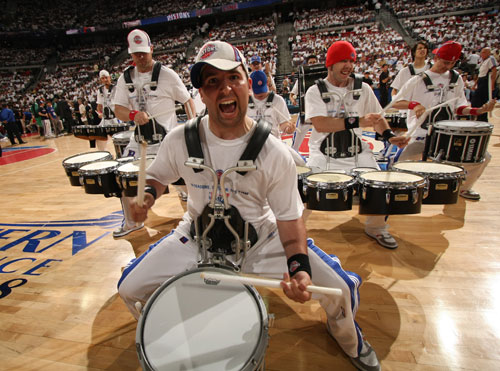Professional drum lines have increasingly become a popular staple of professional basketball with team managers, fans and even the ball players themselves taking note.
Photo by Allen Einstein
Leave it to the pros. At least that’s why Chicago Bulls forward Tyrus Thomas doesn’t play the snare drum.
One day Thomas stumbled upon Scott Idle, director of the Stampede Chicago Bulls Drumline while he was scoping out the United Center sound system with his snare drum. According to Idle, Thomas walked over and jokingly asked if he could try out the drum. But after seeing Idle play—an accomplished percussionist that performed for five years at Michigan State University and with the Cavaliers Drum and Bugle Corps in 2001—Thomas probably thought better of it and said, “Nevermind, man—I don’t want to make a fool of myself. I’ll just stick to basketball.”
Stampede!
There’s no question about it. These guys are professionals.
The Stampede Drumline, which started for the 2007-2008 season, is composed mostly of former Cavaliers members as well as other local drum corps and college band alumni. With just three hours of rehearsal per performance, the group relies on individual talent and drive to bring together an exciting show for each game, according to Idle.
Differently from drum corps, though, Idle values pure entertainment value over rigid corps precision. “It’s the whole largerthan- life idea,” he says. “We’re trying to create characters on the floor. It’s not just about drumming for us. I want everyone to have their own personality and really bring it out.”
The Stampede plays at select Bulls home games, which usually amounts to two to three games per month, and Idle is quick to point out the team’s 10-1 record with the drum line present. The group typically performs during one timeout in the third quarter and then spends the fourth quarter playing to the upper deck of the arena to reach die-hard fans in the “nosebleed” seats. The Stampede will also coordinate with the Bulls game operations crew to start chants throughout the fourth quarter.
“One of the things I talked about … before we actually started the line was that there was a real lack of intimacy with the upper bowl level,” Idle says. “Sometimes, the best fans sit in the cheapest seats. … I think especially for those ticket holders, it’s a pretty cool rush for them to see the Bulls Drumline come up the aisles and stand in the sections. It gets everybody involved.”
The group also performs outside the arena—regardless of the weather—after every Bulls win and will participate in other special events including the opening-day festivities.
“Even if it’s minus 10 degrees, we’re out there playing,” Idle says. “We get crowds of 200 people watching us after the game outside, even if it rains. … When they leave the stadium, the last thing they’re going to see is our electrifying entertainment, and that’s going to make them want to come back.”
Drum Battle
The Stampede isn’t the only drum line or live music group in the NBA, nor was it the first. In fact, Idle attended Michigan State University with Todd Ohme, who started the Detroit Pistons Drumline in 2005. The two have since worked together to share new ideas for their respective groups.
In fact, the two drum lines recently challenged one another to a drum battle at a home game for each team. When the Pistons and Bulls face off in the classic rivalry game, more is at stake than the score. Both musical groups take the floor at the same time and face off, pitting drum performances in similar style to the movie “Drumline.”
While no winner was announced at the competition, both drum lines enjoyed the experience, and according to the two directors, the energy level was through the roof.
“Last year, both of our groups traveled to the away game,” Idle says. “We really got the crowd to feed off of that; it was incredible. During that drum battle, I guarantee you, the Pistons and Bulls were watching us, not listening to their coach.”
Most of the time, the Chicago Bulls Drumline doesn’t interact with the basketball team, but Idle says that team members do take notice of the high-energy performance during a timeout.
All About Image
According to Pistons Drumline director Todd Ohme, a successful NBA drum line is all about the image. Clad in Pistons blue and red sweat suits, the drum line takes the stage with hats and headbands askew, displaying the group’s aggressive attitude.
“We’re really aware of our image,” Ohme says. “We always want to give them something positive. If we’re there leaning against the wall or sitting crosslegged at the end of the game, that’s not very good. They want to see energy, feel the excitement. We want them to know that: ‘You’re at The Palace, and there’s nowhere else to be right now.’”
Ohme echoes Idle’s sentiments about the group’s musicians taking on a “larger-than-life” persona on the court. “Everybody in the group is a phenomenal player,” he says. “But we’ve had guys that are really good that didn’t last because they didn’t connect with the crowd. The hands and the notes, it’s got to sound good and everything, but the big thing is how good can you look, how in control of the drum can you be?”
Something Different
Although nearly every participant in the Pistons and Bulls drum lines has some experience with either corps or college marching band, these groups differentiate themselves with their power-packed performances.
“On the surface, we look like a typical marching band drum line,” says Idle. “But with our background having been part of world-class drum corps, the high degree of talent that we have within the ensemble, it really allows us to do a lot more than what you’d just expect at a high school football game or even a college football game for that matter.”
In addition, the raw talent assembled by these groups allows them to perform well with minimal practice time, a luxury that other marching ensembles are unable to take advantage of.
“Right now, we’re making up our show on the bus,” says Ohme over the cacophony during the drum line’s bus ride to the arena. “Sometimes we have a lot of prep time; sometimes we’re doing it on the fly right before we go out there. … We’ll do at most one rehearsal per game. It’s a three-hour rehearsal. We’ll have a guy that writes most of our parts; he uses Virtual Drumline. He’ll write that, create it and then get it out there. It’s the expectation that we have a practice on Sunday, and you need to get to know it. Sometimes if we don’t have a practice, we really rely on it. It’s a professional gig. Everyone shows up, and they know what they’re doing.”
Ohme’s on-the-fly preparation nonetheless belies the group’s number one mission: to support the team. “We started realizing we need to be very strong here because we’re a big part of the energy in the arena,” he says. “It really has a big impact. The team can be down like 20 points, and we still get a good response from the crowd. We’re there for a reason. We’re not just there because they thought it would be a fun opportunity for us to get to play in front of a bunch of people.”
In addition to performing at select home games and the drum battle with the Chicago Bulls Drumline, the Pistons Drumline also had the opportunity to travel in 2006 to the All-Star Weekend in Houston as well as to perform with Kid Rock and Keith Urban on separate occasions.
Live Experience
Although fans attend NBA games to see basketball, teams are increasingly looking for ways to create a more engaging atmosphere to fill seats night after night. According to Lisa Estrada, director of game operations and entertainment for the Los Angeles Lakers, the Laker Band came into existence at the request of team owner Jerry Buss, who wanted to create a live music atmosphere rather than piping in only recorded charts to the arena. The group began in 1978 when the Lakers still played at the Forum in Inglewood before moving to the Staples Center.
“In the world that we live in with iPods, computers and technology, I hope people don’t forget how special bands are,” Estrada says. “I love it. It’s such a nice tradition, and to have that loyalty is great.”
The Laker Band draws from current and former members of the University of Southern California’s Trojan Marching Band. Unlike most of the other NBA performing groups, however, the Laker Band comprises percussion as well as brass players.
The band performs during timeouts and post game as well as other events with the Lakers team. Estrada says the organization wants them to be “a part of our show in any way, no matter how big or small.”
“It brings a little bit of the live atmosphere,” she adds. “I think tradition again comes to mind. We are a pretty traditional organization, and that’s what our owner likes. He likes the collegiate game atmosphere. That is definitely where we’re unique. We have that collegiate feel.”
Jeff Wolschlager, senior director of game operations for the Chicago Bulls, feels that The Stampede fills a similar role at the United Center.
“Our philosophy is really simple,” Wolschlager says. “We want to make the outcome of the game as moot a point as possible for our fans and make coming to the game as much a value as possible. We look at our basketball floor like a stage. It came out of a desire to have more varied entertainment options.”
NBA Music
There are many live music groups throughout the NBA working hard to keep crowds fired up.
Here are a few of the drum lines and pep bands that we found around the league:
• Chicago Bulls Stampede Drumline
• Dallas Mavericks Drumline
• Detroit Pistons Drumline
• Los Angeles Lakers Laker Band
• Memphis Grizzlies Drumline
• Milwaukee Bucks Wild! Drumline
If you know of more groups, please let us know.


